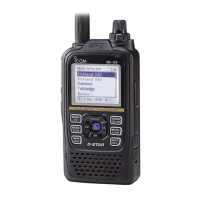4 - 5
4-2 TRANSMIT CIRCUITS
TX AF CIRCUIT (LOGIC UNIT)
The AF signal from the internal or external microphone (MIC
signal) is applied to the audio processor LSI (IC25), through
the ATT (R190 and R198).
The audio processor LSI contains 16-bit liner CODEC, MIC
AMP, audio fi lters, D/A converter, and so on.
• When operating in the DV mode
The applied signal is amplifi ed by the MIC AMP, and passed
through the external MIC mute SW (IC16, pins 7, 1), and then
further amplifi ed by the ALC AMP. The amplifi ed signal is ap-
plied to the liner CODEC, through the LPF (R186, C174 and
C177), to be encoded into a digital audio signal.
The digital audio signal is processed by the DSP (IC18), and
then passed through the LPF (R125 and C124), mode SW
(IC390, Q390) and LPF (IC25) ,and then applied to the D/A
converter (IC25) to be adjusted in level.
The level-adjusted signal is applied to the modulation cir-
cuits.
• When operating in the FM/FM-N mode
The amplifi ed signal is passed through the MIC mute SW
(IC16, pins 7, 1), HPF (R130, C160 and C161), BPF (IC25),
LPF (IC25) and mode SW (IC390, pins 8, 9), and then applied
to the D/A converter (IC25) to be adjusted in level, through
the mode SW (IC390, pins 11, 10) and LPF (IC25).
The level-adjusted signal is applied to the modulation cir-
cuits.
MODULATION CIRCUITS (MAIN UNIT)
The MIC signal from the TX AF circuits is applied to the VHF
VCO (Q311, D304–D306) or UHF VCO (Q27, D10–D12) as
a modulation signal.
The modulation signal is applied to D10 to obtain GMSK (For
DV mode) or Frequency Modulation (For FM mode).
The modulated VCO output signal is amplifi ed by the buffer
(Q200) and LO AMP (Q201), and then applied to the TX AMP
circuits as the TX signal, through the LO SW (D14).
DMO
MMUTE
SW
DV
IC16
LOGIC UNIT
DMOD
EXTMIC
MAIN UNIT
FM
IC390
SW
MODE
LINEAR
CODEC
IC18
DSP
VCOMOD
IC25
HPF
J5
MIC
AMP
MC1
BPF LPF
LPF
ALC
AMP
ATT
LPF
LPF D/A
Q311,
D304,D305,D306
Q201
Q200
MAIN UNIT
VCO A UNIT
Q27,
D10,D11,D12
VHF
UHF
VCO
BUFF
LO
AMP
VCO
TX AMP circuit ->
TX AF circuit ->
• TX AF CIRCUIT
• MODULATION CIRCUIT

